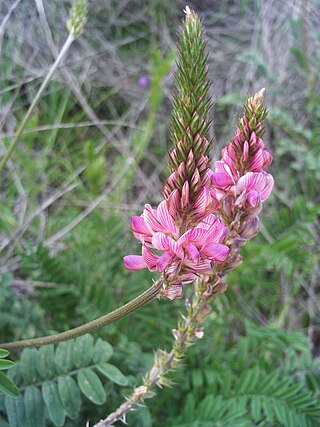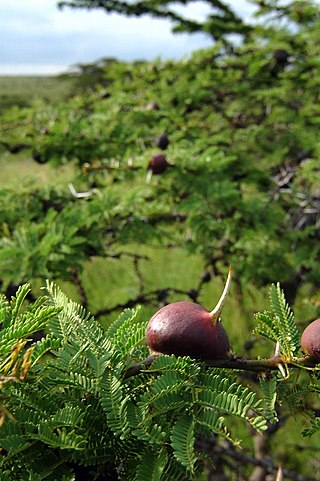
Onobrychis viciifolia, also known as O. sativa or common sainfoin was an important forage legume in temperate regions until the 1950s. During the Green Revolution it was replaced by high yielding alfalfa and clover species. Due to its anthelmintic properties, common sainfoin is a natural alternative to drugs to control nematode parasitism in the guts of small ruminants. This is the main reason why O. viciifolia returned to the scientific agenda in recent years.

Tannins are a class of astringent, polyphenolic biomolecules that bind to and precipitate proteins and various other organic compounds including amino acids and alkaloids.

Polyphenols are a large family of naturally occurring phenols. They are abundant in plants and structurally diverse. Polyphenols include phenolic acids, flavonoids, tannic acid, and ellagitannin, some of which have been used historically as dyes and for tanning garments.

Guibourtia is a flowering plant genus in the family Fabaceae, also known by the common names as Rhodesian copalwood, African Rosewood, amazique, bubinga, kevazingo, and ovangkol.

Rosewood is any of a number of richly hued hardwoods, often brownish with darker veining, but found in other colours. It is hard, tough, strong, and dense. True rosewoods come from trees of the genus Dalbergia, but other woods are often called rosewood. Rosewood takes a high polish and is used for luxury furniture-making, flooring, musical instruments, and turnery.

Procyanidins are members of the proanthocyanidin class of flavonoids. They are oligomeric compounds, formed from catechin and epicatechin molecules. They yield cyanidin when depolymerized under oxidative conditions.

Faidherbia is a genus of leguminous plants containing one species, Faidherbia albida, which was formerly widely included in the genus Acacia as Acacia albida. The species is native to Africa and the Middle East and has also been introduced to Pakistan and India. Common names include apple-ring acacia, white acacia, and winter thorn. The South African name is ana tree.

Vachellia drepanolobium, more commonly known as Acacia drepanolobium or whistling thorn, is a swollen-thorn acacia native to East Africa. The whistling thorn grows up to 6 meters tall. It produces a pair of straight spines at each node, some of which have large bulbous bases. These swollen spines are naturally hollow and occupied by any one of several symbiotic ant species. The common name of the plant is derived from the observation that when wind blows over bulbous spines in which ants have made entry and exit holes, they produce a whistling noise.

Luengue-Luiana National Park is a national park in Angola.
A Proguibourtinidin is a type of condensed tannins formed from guibourtinidol (leucoguibourtinidin). They yield guibourtinidin when depolymerized under oxidative conditions.

Cassia abbreviata, commonly known as the sjambok pod or long-tail cassia, is a mostly tropical tree species in the genus Cassia, which is native to Africa.

African rosewood is a common name for several plants and may refer to:
Quebracho is a common name in Spanish to describe very hard wood tree species. The etymology of the name derived from quiebrahacha, or quebrar hacha, meaning "axe-breaker". The corresponding English-language term for such hardwoods is breakax or breakaxe.

Condensed tannins are polymers formed by the condensation of flavans. They do not contain sugar residues.

Quercus infectoria or the Aleppo oak is a species of oak well known for producing galls that have been traditionally used for centuries in Asia medicinally while also used in softening leather and in making black dye and ink.
Mopane, Colophospermum mopane, is a tree in the legume family that grows in southern Africa.

Bwabwata National Park is a protected area in northeastern Namibia that was established in 2007 and covers 6,274 km2 (2,422 sq mi). It was created by merging Namibia's Caprivi Game Park and Mahango Game Park. It is situated in the Zambezi and Kavango East regions, extending along the Caprivi Strip. It is bounded by the Okavango River to the west and the Kwando River to the east. Angola lies to the north and Botswana to the south.

Breonadia is a monotypic genus of flowering plants in the family Rubiaceae. It was described by Colin Ernest Ridsdale in 1975. The genus contains only one species, viz. Breonadia salicina, which is found in tropical and southern Africa from Mali and Benin east to Ethiopia, south to South Africa, as well as Yemen, Saudi Arabia and Madagascar.

Commiphora angolensis, also known as sand commiphora or sand corkwood, is a shrub species in the genus Commiphora growing mainly in Angola and Namibia.
Guibourtia tessmannii is a species of legume in the family Fabaceae. It is a medium to large-sized tree and is native to Cameroon, Gabon and Equatorial Guinea. The timber has an attractive appearance and has many uses, and the bark is used in traditional medicine.
















